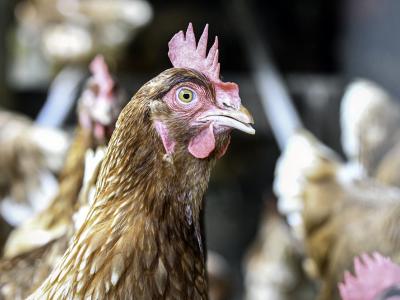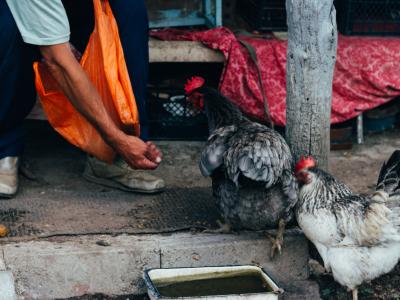Mar 2, 2006 (CIDRAP News) – China's vice premier said today that China may see more bird outbreaks and human cases of avian influenza this spring, as the government announced plans for an intensive hunt for cases among wild birds on a major migration route, according to news services.
The news from China came as Germany confirmed that a cat was infected with the deadly H5N1 virus and Serbia reported its first suspected avian flu case in a wild bird, among other developments.
In China, Vice Premier Hui Liangyu said a "comprehensive analysis" indicates that the country is at risk for more trouble with avian flu this spring, according to an Associated Press (AP) story based on a report from the Chinese news agency Xinhua. Hui heads the national office for preventing and controlling the disease, the story said.
In an Agence France-Press (AFP) report, Hui was quoted as saying, "This spring, there is still a possibility that bird flu will erupt and spread in China." Speaking at a national teleconference, he added, "There is still a risk that the number of human cases will continue to increase."
To at least one expert, the Chinese statement sounded like a hint that avian flu in China is more widespread than the government has been acknowledging.
"Many of us believe that this type of discussion by someone as high as the vice premier really indicates that this situation is already occurring," said Michael T. Osterholm, PhD, MPH, director of the University of Minnesota Center for Infectious Disease Research and Policy, publisher of the CIDRAP Web site.
"You don't see these kinds of statements coming out of the government of China very often," he added.
Osterholm said he has been told there is more avian flu in China than has been reported publicly. "I can't say the sources, but there are more [human] cases going on in China than have been released and reported to the World Health Organization. Also, there's information from a variety of sources suggesting the level of bird infections is substantially higher than is being reported."
He said his information came from "sources on the ground in China as well as other informed government sources."
Osterholm added that China and the rest of Asia are still the place where avian flu poses the biggest risk of sparking a human influenza pandemic. "While the spread of the virus around the world is an important consideration, the potential for the ongoing mutation of the virus toward a human-to-human transmitted strain is probably more likely where the high virus density and high bird population exist, and that's in China and the rest of Asia."
He said that all of Africa has fewer than a billion chickens, whereas China produces 15 billion a year. "That's where the genetic roulette table for mutations is," he said.
The AP report from China said the government is setting up an avian flu surveillance system in the eastern province of Jiangsu to focus on wild birds. The system will consist of 100 monitoring stations staffed by 1,000 workers throughout the province.
Experts estimate that about 3 million migratory birds will fly to Jiangsu in the next 2 months and that another 5 million birds will pass through, according to the Xinhua story cited by the AP.
"Inspectors will check dead birds and test droppings, and any sign of bird flu will trigger an emergency response," the AP reported.
Meanwhile in Germany, health officials confirmed that a cat on the Baltic Sea island of Ruegen died of H5N1 infection, AFP reported today. The case is the first known H5N1 infection in a mammal in Europe.
European Union (EU) veterinarians in Brussels have urged people to keep their cats indoors and dogs leashed in areas affected by avian flu, according to AFP. And a German humane society said the case has already prompted hundreds of German cat owners to leave their pets at shelters, the story said.
In Serbia, authorities reported finding an H5 flu virus in a dead swan found in the northwestern part of the country, near the borders of Croatia and Hungary. Both the latter countries have had H5N1 cases in wild birds, but this would be the first known case in Serbia.
Serbian officials said samples from the swan would be sent to the EU reference lab in Weybridge, England. They vowed to take precautions against spread of the virus without waiting for the test results.
In Indonesia, a 13-year-old girl and her 10-year-old brother recently died of suspected avian flu in Central Java province, according to another AFP report.
The girl died yesterday after being treated for 9 days at a hospital in the town of Solo, the report said. Her younger brother died a day earlier at a local hospital in their home town of Boyolali.
A doctor told AFP that the children lived near a farm and both had been in contact with sick chickens.
In Iraq, a woman has died of suspected avian flu in the southern province of Nasiriyah, according to another AFP report. If her case is confirmed, it would be the third one in Iraq.
In southern Russia, avian flu has killed almost half a million domestic birds in the past month, despite culling efforts, according to a Los Angeles Times report today. The Emergency Situations Ministry said the H5N1 virus has killed about 495,000 birds in regions near the Caspian and Black seas, and another 220,000 birds have been killed in containment efforts.
Russian Agriculture Minister Alexei V. Gordeyev said yesterday the country will begin mass vaccinations of poultry on Mar 10, the report said.
Elsewhere, more infected wild birds were found in Austria and France, while authorities in the Bahamas said it was unlikely that some dead birds in a national park on the island of Great Inagua had H5N1 avian flu.



















